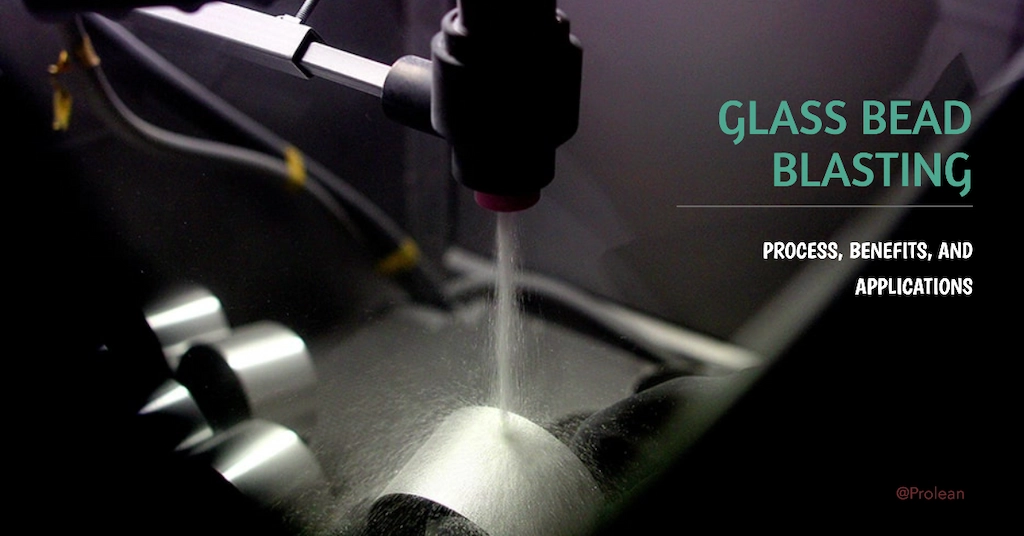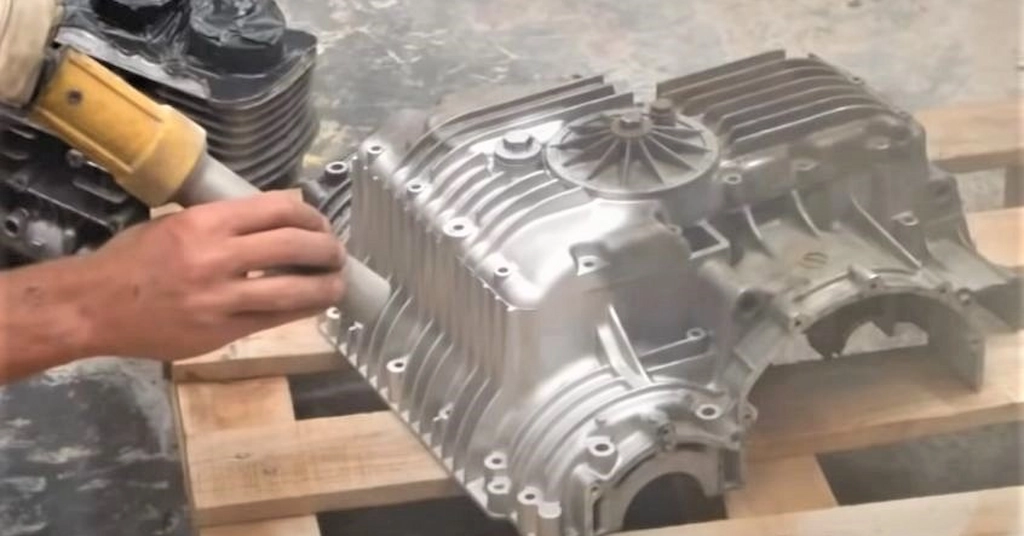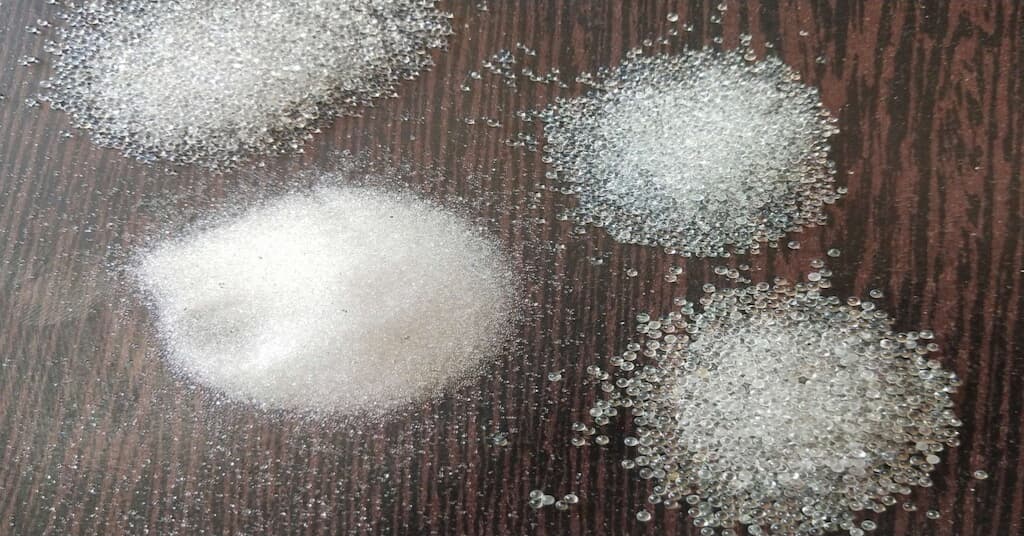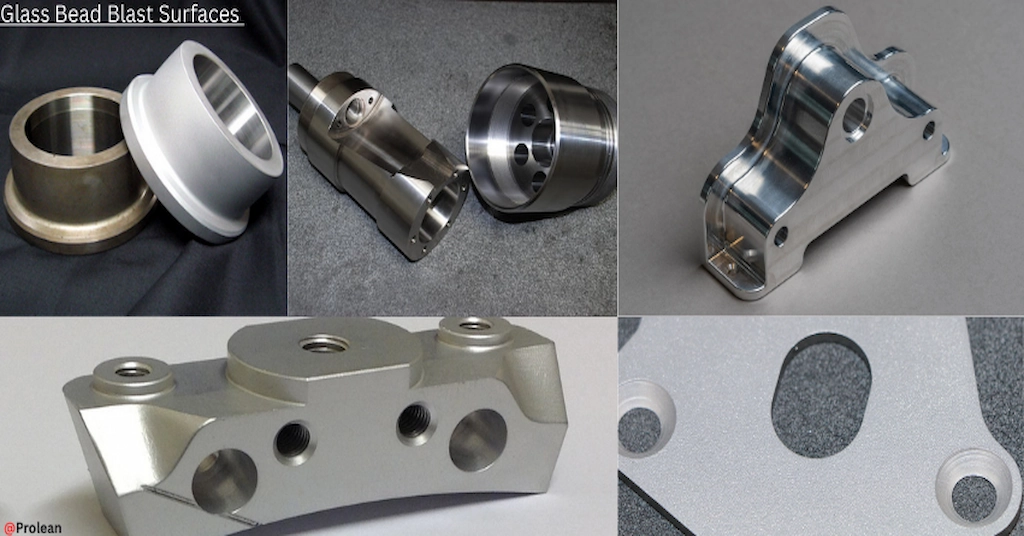“Using glass beads for blasting ensures a smooth, satin-like finish on metals and other materials. It is beneficial for delicate surfaces as it does not cause any surface damage.”

The bead blasting finish uses abrasive beads made of different materials, such as steel, aluminum oxide, glass, and ceramic. The jet of air mixed with any of the above beads removes the minor material from the substrate surface and provides a smooth finish. Among many, glass bead blast is known for its precise material removal without causing surface defects. This means that it removes a thinner material layer than other material beads.
Furthermore, this post will elaborate on the glass beads, the working of glass beadblasting, suitable materials, advantages, disadvantages, and applications.
What is Glass Bead Blasting?

Glass beadblasting on engine part
It is a type of beadblasting finish that involves striking fine glass beads at high pressure onto a surface to clean, deburr, peen, and smooth it for a uniform finish. Typically, the size of beads can go up to 850 µm depending on the level of finish required. Furthermore, it works with both ferrous and nonferrous alloys, along with some plastics.
This low aggressive blasting is the best alternative to sandblasting, where highly coarse sand particles sweep away more material volume of the workpiece. Meanwhile, the glass blasting media performs significant material removal compared to bead blasting and sandblasting. The main action of glass beads is removing the surface imperfections of manufactured parts, such as tool marks, minor cracks, attached chips, burrs, etc.
Glass beads are also used to prepare the surface for subsequent finishing or plating, such as electroplating, zinc coating, anodizing, and painting. The beads make the surface uniform and defect-free, and then costing is applied for performance or appearance.
Try Prolean Now!
Glass Beads
Glass beads are made from a composition of silica (SiO₂, 65-75%) with small proportions of calcium oxide (CaO), sodium oxide (Na₂O), magnesium oxide(MgO), and a few other metal oxides in minor amounts. Meanwhile, none of these constituents introduces any impurities on the substrate surface.

Glass blasting media
Furthermore, the physical and mechanical properties of glass beads facilitate the lite but effective material removal without causing any damage. The hardness allows for removing the contaminants; their spherical shape ensures a consistent and smooth finish, and their recyclability makes them cost-effective and sustainable.
Consequently, the table below illustrates the standard sizes of glass bead blast media and their corresponding uses.
Table: Typical Sizes of Glass Media Blasting Beads
| Glass Bead Size (µm) | When to Use |
| 0-50 µm | Fine polishing and delicate surfaces |
| 40-70 µm | Light cleaning and polishing |
| 70-110 µm | General cleaning and surface preparation |
| 90-150 µm | Removing light burrs and blending surfaces |
| 100-200 µm | Surface finishing and preparation for painting |
| 150-250 µm | Deburring and surface smoothing |
| 200-300 µm | Heavy cleaning and surface finishing |
| 300-400 µm | Removing thick contaminants and surface coatings |
| 425-850 µm | Rough cleaning and peening applications |
How Does Glass Bead Blast Finish Work?
The fundamental process of glass media blasting is similar to any other beadblasting technique. It involves striking the glass beads at the surface using a jet of compressed air. The beads are mixed in a chamber with compressed air, and the bead blasting gun throws away the abrasive stream towards the workpiece surface at a pre-determined speed. When they strike, the beads gently remove contaminants and irregularities. Subsequently, the main components of a glass bead blasting setup include a blasting cabinet, air compressor, blasting gun, and dust collector.
- Blasting Cabinet: An enclosed space where blasting occurs, preventing debris from escaping.
- Air Compressor: It provides the necessary compressed air to propel the glass beads.
- Blasting Gun: A handheld or automatic tool that directs the flow of glass beads onto the surface.
- Dust Collection System: It removes dust and spent beads from the cabinet to maintain visibility and cleanliness.
Which Materials are Compatible with Glass Blasting Media?
The glass blasting media can work with a variety of metals, alloys, plastics, and composites. However, the size of the beads and the pressure of blasting can differ based on the substrate material type. The list of compatible materials for glass bead blasts is as follows.
- Stainless steel
- Aluminum
- Titanium
- Steel Alloys
- Copper
- Brass
- Polycarbonate
- Polypropylene
- Nylon
- ABS
- Acrylic
- Industrial rubbers
- Carbon fiber, etc.
The glass bead blast media can perform deburring, honing, peening, and polishing on these materials’ machined, fabricated, or casted parts.
What Are the Advantages of Glass Bead Blast in Surface Finishing?
Glass beads are suitable for fine detail to finish on a variety of manufactured parts and products made from diverse materials. So, glass bead blast media is a flexible process that considers the complexity of materials and parts. The main advantages of glass bead blast are;
- Material Versatility: It suits various materials, including metals, plastics, composites, ceramics, and glass, making it a versatile surface finishing option.
- Minimal Damage: The spherical shape and gentle abrasiveness of glass beads ensure minimal damage to the surface, preserving the integrity and structural properties of the material.
- Complex Geometries: Glass bead blasting can effectively clean and finish intricate and complex geometries, reaching areas other methods might miss and ensuring uniformity and precision.
- Surface Preparation for Electroplating: It provides an ideal surface for electroplating by creating a clean, smooth, and slightly roughened texture, improving the adhesion of the plating material.
- Recyclability of Beads: Glass beads can be reused multiple times, making the process cost-effective and environmentally friendly by reducing waste.
- Gentle Material Removal: The gentle material removal properties of glass bead blasting make it suitable for delicate surfaces, ensuring effective cleaning and finishing without excessive wear or damage.
What Are the Disadvantages of Glass Bead Blasting?
The disadvantages of glass bead blasting are;
- It is unsuitable for heavy material removal due to its limited abrasive capability.
- The glass blasting process requires a controlled temperature as high temperatures can clump the glass media.
- If beads and equipment are not cleaned properly, it can lead to surface contamination and the quality degradation of the finished products.
- Some materials can oxidize and form rust after blasting in the presence of moisture or a humid environment.
Glass Bead Blast Applications

Glass Bead blast surfaces
The glass bead blast is used in various machining or manufactured parts and products; small sizes are for fine smoothing, moderate sizes are for cleaning and surface irregularity, and large glass beads are for rough, aggressive surfaces. Subsequently, less material removal also allows for the finishing of small-size workpieces.
The Table below shows the typical applications of glass beadblasting in depth with examples;
Table: Glass Blasting Finish Applications
| Industry | Why Glass Beads? | Specific Examples |
| Automotive | Non-destructive cleaning, surface preparation, and aesthetic finishing | Engine components, aluminum wheels, transmission parts |
| Aerospace | Precision cleaning and finishing, reducing surface stress | Aircraft turbine blades, landing gear, structural components |
| Electronics | Gentle cleaning of delicate components | Circuit boards, connectors, semiconductor devices |
| Medical | Sterilization and surface preparation for implants and instruments | Surgical instruments, orthopedic implants, dental tools |
| Marine | Removal of marine growth and corrosion | Ship hulls, propellers, marine hardware |
Try Prolean Now!
Summing Up
Gentle material removal is critical in various post-processing conditions, such as for sensitive dimensional and thin sheet components. In this context, glass bead blast is ideal for getting a uniform matt texture finish, which can be either directly used as end products or painted or coated with additional materials. However, operators’ blasting equipment and expertise are equally essential to achieve the quality result.
At ProleanTech, we have advanced blasting cabinets and automatic blaster guns for precision removal. Our Bead Blasting Service accommodates various sizes of glass beads(delicate to coarse) according to your requirements. Additionally, our decade of experience in manufacturing and surface treatment can meet your stringent requirements. So, request a quote, and we will get back to you with detailed cost and other production information.
FAQs
When to use glass beads for beadblasting finish?
Glass beads are ideal when you need a non-destructive, uniform finish for cleaning, deburring, or preparing surfaces for further treatment.
Can I use glass bead blast on aluminum parts?
Yes, glass bead blasting is safe and effective for aluminum parts. It gently cleans and polishes the surface without causing damage. Glass beads are suitable for aluminum machined parts like engine parts and wheels.
What is the difference between sand and glass bead blasting?
Sandblasting is more abrasive and suited for heavy-duty material removal, while glass bead blasting is gentler and ideal for polishing and finishing delicate surfaces without causing damage.
Are glass bead blasting safe to use?
Yes, glass bead blasting is safe when proper safety measures are followed. Operators should wear protective gear, including gloves, goggles, and respirators.




0 Comments